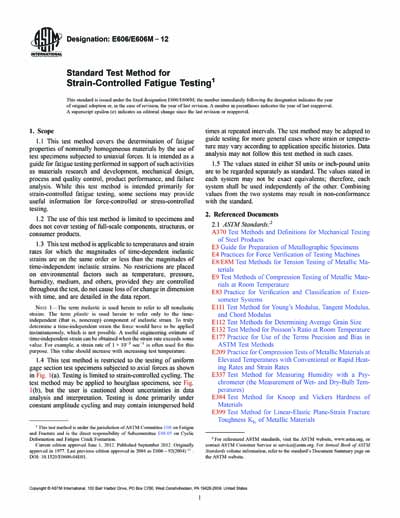Historical
ASTM E606/E606M-12
Standard Test Method for Strain-Controlled Fatigue Testing
1.1 This test method covers the determination of fatigue properties of nominally homogeneous materials by the use of test specimens subjected to uniaxial forces. It is intended as a guide for fatigue testing performed in support of such activities as materials research and development, mechanical design, process and quality control, product performance, and failure analysis. While this test method is intended primarily for strain-controlled fatigue testing, some sections may provide useful information for force-controlled or stress-controlled testing.
1.2 The use of this test method is limited to specimens and does not cover testing of full-scale components, structures, or consumer products.
1.3 This test method is applicable to temperatures and strain rates for which the magnitudes of time-dependent inelastic strains are on the same order or less than the magnitudes of time-independent inelastic strains. No restrictions are placed on environmental factors such as temperature, pressure, humidity, medium, and others, provided they are controlled throughout the test, do not cause loss of or change in dimension with time, and are detailed in the data report.
Note 1—The term inelastic is used herein to refer to all nonelastic strains. The term plastic is used herein to refer only to the time-independent (that is, noncreep) component of inelastic strain. To truly determine a time-independent strain the force would have to be applied instantaneously, which is not possible. A useful engineering estimate of time-independent strain can be obtained when the strain rate exceeds some value. For example, a strain rate of 1 × 10−3 sec−1 is often used for this purpose. This value should increase with increasing test temperature.
1.4 This test method is restricted to the testing of uniform gage section test specimens subjected to axial forces as shown in Fig. 1(a). Testing is limited to strain-controlled cycling. The test method may be applied to hourglass specimens, see Fig. 1(b), but the user is cautioned about uncertainties in data analysis and interpretation. Testing is done primarily under constant amplitude cycling and may contain interspersed hold times at repeated intervals. The test method may be adapted to guide testing for more general cases where strain or temperature may vary according to application specific histories. Data analysis may not follow this test method in such cases.
1.5 The values stated in either SI units or inch-pound units are to be regarded separately as standard. The values stated in each system may not be exact equivalents; therefore, each system shall be used independently of the other. Combining values from the two systems may result in non-conformance with the standard.
ASTM International [astm]

